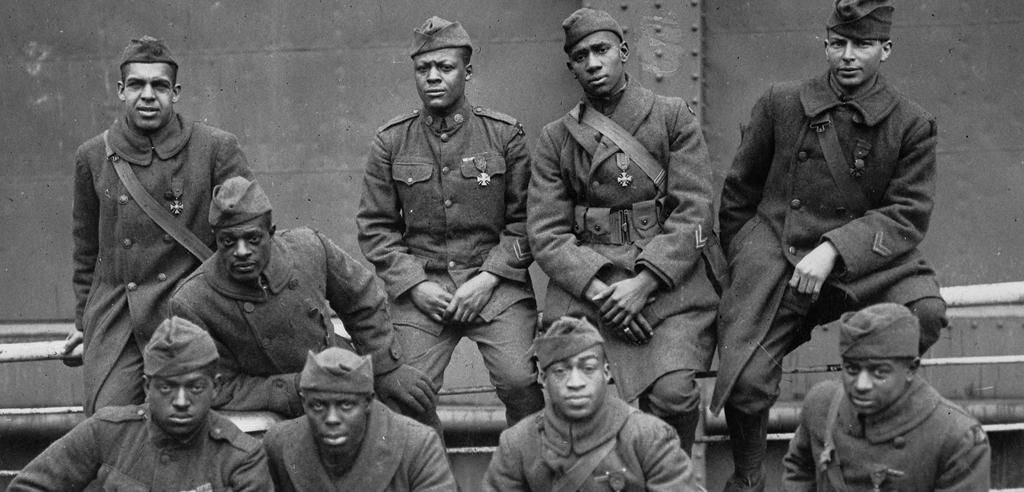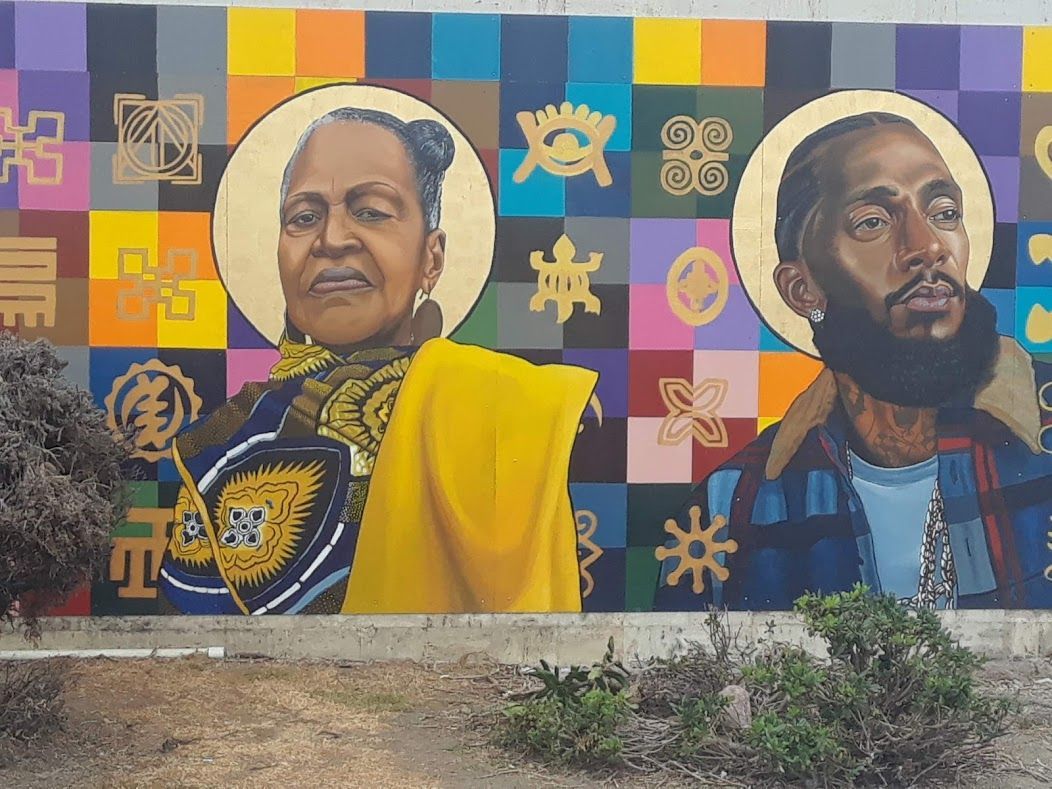“It Feels Like We’re Profiting Off Of Black Death”: Tulsa Residents See Civil Rights Tourism But No Reparations
One hundred years have passed since the Tulsa massacre, but little has been done to make amends or improve the lives of Black residents, whose fate can be decided by their zip code.
TULSA, Oklahoma — Just feet from the highway that divides Black and white Tulsa stands a shrine to Black resiliency.
A century ago, Vernon African Methodist Episcopal Church was the only Black house of worship left standing in the city after a white mob descended on the Greenwood district, a prosperous neighborhood dubbed Black Wall Street, razing 35 square blocks of businesses and homes, and killing as many as 300 people.
This past week, on a cold and rainy Memorial Day morning, 100 years to the day since the campaign of terror began, a crowd gathered along the church’s southern rampart for an interfaith service dedicating a new prayer wall honoring victims of the 1921 massacre. The crowd included a mix of national civil rights leaders and politicians who had come to town for the official anniversary commemorations.
“It’s hard for me to smile today,” said Rep. Lisa Blunt Rochester of Delaware over the hum of the traffic on I-244. “I feel this ground today, but I also see a highway that went through a city. So we are here to remember, to mourn, and to rebuild equitably.”
But missing from the crowd were the three survivors of the attack who are still alive: Hughes Van Ellis, 100, known around town as “Uncle Red”; his 107-year-old sister, Viola Fletcher (“Mother Fletcher”); and Lessie Benningfield Randle (“Mother Randle”), 106.
Instead, Van Ellis and Fletcher were just half a mile away at another memorial event, receiving bouquets of flowers and medals in a more somber ceremony organized by local activists where people wept as they honored those who were killed in the massacre and whose names are still unknown.
This is how Memorial Day weekend went in Tulsa — two conflicting groups hosting centennial events. One, the Tulsa Race Massacre Centennial Commission, well funded and connected to state Republican leadership; the other, the Black Wall Street Legacy Festival, run by survivors and descendants pushing for justice for the three surviving elders in the form of reparations.
“In the case of Tulsa, they’ve had 100 years to make amends,” said Dreisen Heath, a researcher and advocate on racial justice at Human Rights Watch who authored an influential 2020 HRW report on the need for reparations in Tulsa, “and putting on events in celebration of continued loss is not the answer.”
There is division in Tulsa — Black and white, north and south, electeds and activists — but there is also righteous anger. Survivors and activists are furious not only at the continued absence of any reparations, but also at what has been a century of underinvestment in Black communities. This neglect has had painful and very real implications for Black Tulsans, whose health and wealth can be determined by their zip code. All the while, they say, some local and state officials have been seeking to promote the Tulsa anniversary as a rebranding opportunity, pushing a form of civil rights tourism in the city that belies legislative antagonism to the Black Lives Matter movement.
“To this day, I can barely afford my everyday needs,” Fletcher told a congressional hearing last month. “All the while the city of Tulsa have unjustly used the names and stories of victims like me to enrich itself and its white allies through the $30 million raised by the Tulsa Centennial Commission while I continue to live in poverty.”
The division between commemorations this past weekend can be traced back to 2015, when state lawmakers established the 1921 Tulsa Race Massacre Centennial Commission to plan for the 100th anniversary. In the six years since, the group raised over $30 million from Oklahoma’s philanthropic and corporate elite. But community leaders in north Tulsa lost faith in the commission as it became clear that the bulk of that money raised, $20 million, would go to building a museum on the other side of the highway. No money had been set aside for compensating survivors and descendants despite decades of calls for reparations. In the week leading up to the centennial, the commission partnered with a PGA tournament at Tulsa’s Southern Hills Country Club. The club, which effectively banned Black members for decades, is invitation-only with a membership fee that has been reported to cost up to tens of thousands of dollars.
For many in north Tulsa, this was just the latest slight by officials who have never taken responsibility for the state’s role in the 1921 massacre. If they were going to properly honor the remaining survivors before they died, community leaders decided they had to host their own events.
“We felt left out of the centennial,” said Greg Robinson, a north Tulsa community activist. He helped organize the Legacy Festival because the official commission didn’t seem interested in the local events that the community had been running for years.
“Sometimes great things are created out of stressful situations,” he said.
Like many cities in the US, Tulsa’s neighborhoods are still divided along largely racial lines and the disparities between its mostly Black north and white south are stark. The median income in one south Tulsa zip code is roughly $81,000. In one area on the north side, that figure drops to $25,000. Similarly, the life expectancy in one northern zip code is 12 years lower than one in south Tulsa. Black Tulsans represent 15% of the total population, but just 5% of small business owners. They are also far less likely than white Tulsans to own their own homes.
“You don’t see the investment in north Tulsa that you see in south Tulsa and other parts of the city,” said Latasha Woods, who moved to mostly white Midtown Tulsa to get her daughter, Keyaireah Smith, now 19 and just finishing her first year at Oklahoma State University, into a better high school.
Woods said she was happy with the national attention her city was getting due to the anniversary, but was concerned that nothing would change when the spotlight shifted away once again.
“I think it’s good what’s going on right now, but I think when everything dies down, everything will go back to being the same,” she said. “Because it’s been so long, they had so many opportunities to provide this community with what they need.”
Politics has also stirred division in Tulsa and across Oklahoma. Frustrations started to bubble over last year, when then-president Donald Trump announced that he would hold his first rally during the pandemic in the city on Juneteenth, a holiday recognizing Black liberation from slavery. Black leaders were furious that Republican Mayor G. T. Bynum had agreed to give a platform to a president who had made numerous overtures to white supremacists on Juneteenth of all days. Eventually, the rally was pushed back a day, but still Black leaders in Tulsa felt that the mayor had displayed a complete disregard for the city's Black community.
“Our mayor allowed that to happen,” said Tiffany Crutcher, the lead organizer of Legacy Festival, who rose to national prominence after her twin brother, Terence, was shot and killed by a Tulsa police officer in 2015. She now runs the Terence Crutcher Foundation out of the Greenwood Cultural Center, located across the street from Vernon AME Church.
Since the Trump rally, Mayor Bynum, who sits on the centennial commission, has continued to insist that reparations — which many in north Tulsa saw as key for any centennial remembrance — would divide the city.
“That’s when we started to say, ‘You know what? No, we’re not going to allow it,’” said Crutcher. “We’re not going to allow our history to be controlled yet again by what controlled and decimated Greenwood.”
The mayor wasn’t the only member of the commission who frustrated north Tulsans for not centering — or worse, working against — Black voices. Last month, Oklahoma’s Republican governor, Kevin Stitt, was kicked off the commission after he signed a bill banning the teaching of critical race theory in schools, a law that educators say limits their ability to talk freely about the massacre, its causes, and its consequences. Stitt also signed legislation in April that grants immunity for some drivers who hit protesters with a vehicle if they are blocking the road, after a driver hit three Black Lives Matter demonstrators last year, paralyzing one.
Sen. James Lankford, one of two Republican senators representing Oklahoma in Congress, also faced calls for his removal from the commission after playing a central role in spreading racist myths of voter fraud and questioning the results of the 2020 presidential election. Lankford had refused to acknowledge that Joe Biden had legitimately been elected until after the Capitol insurrection. Lankford ultimately stepped down from the commission last week, calling it too partisan.
Stevie “Dr. View” Johnson, a community organizer and executive producer of Fire in Little Africa, a hip-hop collective created for the centennial, said Oklahoma politicians were more interested in turning the city into a civil rights tourism destination, akin to the Alabama cities of Selma or Montgomery, than in caring for Black residents.
“It feels like we’re profiting off of Black death,” said Johnson. “If the funds were going to the place where it needed to go, I would have no problem with it — that is our history, these are our stories. But because that hasn't been addressed, it just really makes me sick to my stomach.”
Instead, Crutcher, the lead Legacy Festival organizer, said she and others wanted to reclaim the narrative — and the power — for Black Tulsans.
“It was all a matter of who controls the history, who controls the stories,” she said, “and we wanted to make sure that we didn’t allow other people to water down our history.”
Crutcher and other Black community leaders decided to create a festival centered on survivors and descendants, and calling for reparations. With the backing of organizations including Human Rights Watch, Equal Justice Initiative, the Black Wall Street Times, and Justice for Greenwood, they held anniversary marches and luncheons for survivors. Legacy Festival also hosted panels focused on racial justice, white supremacy in 2021, and the need for reparations, with appearances from civil rights attorney Ben Crump, racial justice advocate and Insecure actor Kendrick Sampson, and Rep. Sheila Jackson Lee of Texas.
The two jewels of the state-sponsored commission’s centennial events were supposed to be the opening of Greenwood Rising, a $20 million museum about the massacre, and the Remember and Rise event, which was to feature voting rights activist Stacey Abrams speaking and singer John Legend performing on Memorial Day.
But ultimately the commission failed to deliver either.
At 8 p.m. on Friday night of the holiday weekend, construction workers were still working on the museum’s entrance, hurriedly preparing for a commission-run dedication ceremony on Wednesday. But Greenwood Rising is still behind schedule due to construction issues and won’t open fully until at least July, according to a publicist for the museum.
The museum is also mired in controversy. One survivor, Mother Randle, has sent a cease-and-desist letter to stop its association with her. North Tulsans and descendants have been furious that the money was spent on building a new museum on the mostly white side of the interstate instead of expanding Greenwood Cultural Center, a long-standing community center just north of the highway. The proceeds from the museum will also not be allocated to survivors or descendants.
“Museums are not going to give us back what my family had lost out on all of these years,” said Valerie Walker, whose grandfather Harry Gamble Jr. was a toddler during the riots and whose family left Tulsa in the years after the riots.
“You owe people what you took from them,” said Walker. “Sometimes money is the only thing that cures things.”
Centennial weekend was the first visit to Tulsa for Walker’s 24-year-old granddaughter, Tiara Sank, who was keen to see the neighborhood she’d heard so many stories about over the years from her grandmother. Sank is a nursing student in Texas, but she wonders if her dreams may have been bigger if the massacre hadn’t devastated her family
“I always wondered if we would have kept that going, what happened in Greenwood, what could I have been?” said Sank. “If that’s how we were living back then, what could we have become? What if I could become a doctor or even had my own medical facility? Or even something greater than that?”
Abrams and Legend ultimately pulled out of the Memorial Day concert after speaking with Black Tulsans and learning that survivors and descendants were frustrated with organizers and were not participating. The head of the commission, state Sen. Kevin Matthews, has said the concert fell apart after survivors, who had never agreed to be part of the event, demanded $50 million in reparations. The survivors’ lawyer and others in the meetings denied his claims.
Matthews, who is a descendant himself, said he’s not against the state and federal governments paying reparations, but that his commission raised money from corporations and foundations specifically for a museum. He believes such a venue is an important first step on the road to doing right by Black Tulsans.
“When Jews had the Holocaust, they built a museum to the tell the story. When Hiroshima happened, the Japanese built a museum to tell the story. So that’s what we’re doing,” said Matthews. “You start with telling the story so that you have a narrative to build from.”
Matthews, who represents north Tulsa, said he understood the frustrations with his commission and what it was and wasn’t able to achieve. But as a Democrat in one of the most Republican states in the country, and one of just two Black senators in Oklahoma, he’s used to reining in his vision of what is possible.
“I get criticized for working with white Republicans. Although there are some policies I disagree with and some that are egregious to my community, the fact is us Democrats are in a super minority,” he said.
“We have to have a long-term strategy,” Matthews said. “We have to play chess, not checkers.”
For many Black Tulsans, though, the effective implosion of the state-sponsored commission was a fitting turn for an effort they saw as misguided.
“John Legend is not from Tulsa and I mean no disrespect to him and what he does, but I support my own,” said Melisha Calvert, a north Tulsa native, who had come down to the Legacy Festival with her daughter, Langstyn, a 10-year-old dancer who got to perform at a studio in Greenwood during the festival. “I really want to see my own hit the stage. We have a lot of richness here. We have a lot of great artists here, so let's celebrate them.”
For Calvert and others, this was a chance to spotlight what was good about her community.
“I was born and raised here in north Tulsa. I see the hardships, but I also see what's coming up,“ she said. “North Tulsa gets a lot of negative attention, but we have a lot of positiveness that nobody recognizes. That’s what we’re seeing this weekend.”
One of the shining examples of what locals love about north Tulsa was on display this holiday weekend. Fire in Little Africa, a collective of more than 60 hip-hop artists from Oklahoma, released an album Friday through Motown Records for the centennial. The music tells the story of Black Wall Street before the massacre, imagines a world where the tragedy didn’t happen, and wrestles with its traumatic aftermath.
Artists recorded the album in March 2020 in the days before pandemic lockdown, mostly at the Greenwood Cultural Center, a community space filled with art, tales from survivors, and local foundations. The collective’s name comes from a news photo from 1921 showing Greenwood on fire with the words “Little Africa on fire” scrawled across it.
“Dr. View” Johnson, the collective organizer, said that, unlike some, his group wanted to tell the authentic story of what is happening in their city. “You have people in positions of power, white and black, who are allowing the optics, the respectability politics, to get in the way of what's happening,” he said.
On Saturday night, in a haze of golden sunset, hundreds of Black people — many of whom were longtime north Tulsa residents and descendants of massacre victims — pulled up lawn chairs in what is normally an empty field next to a University of Oklahoma-Tulsa’s parking lot for the first performance of Fire in Little Africa.
As old friends hugged each other and children played freely in the crowds, people danced in “Black Lives Matter'' and “Black Wall Street” T-shirts. The lines were long for the trucks offering brisket and ribs, and local vendors selling shea butter, candles, and clothing were enjoying a busy trade.
“For me to be back here on Greenwood actually selling a product that I had made — knowing what Black Wall Street means and what it was — is like coming full circle,” said Mai Cazenave, whose Enlighten Candle Company stall had been so busy she’d already sold out three-quarters of her stock. “Today has been all about my ancestors and honoring my ancestors.”
Honoring ancestors for Cazenave and others in attendance meant celebrating what is still good about north Tulsa. Much was lost 100 years ago and never rebuilt, but locals wanted the world to see that this is still a proud community, still a center of Black excellence.
As the sun sank beyond the horizon, rapper St. Domonick addressed the crowd before performing his track “Reparations.”
“They can’t kill us,” he declared. “We’re still here.”









